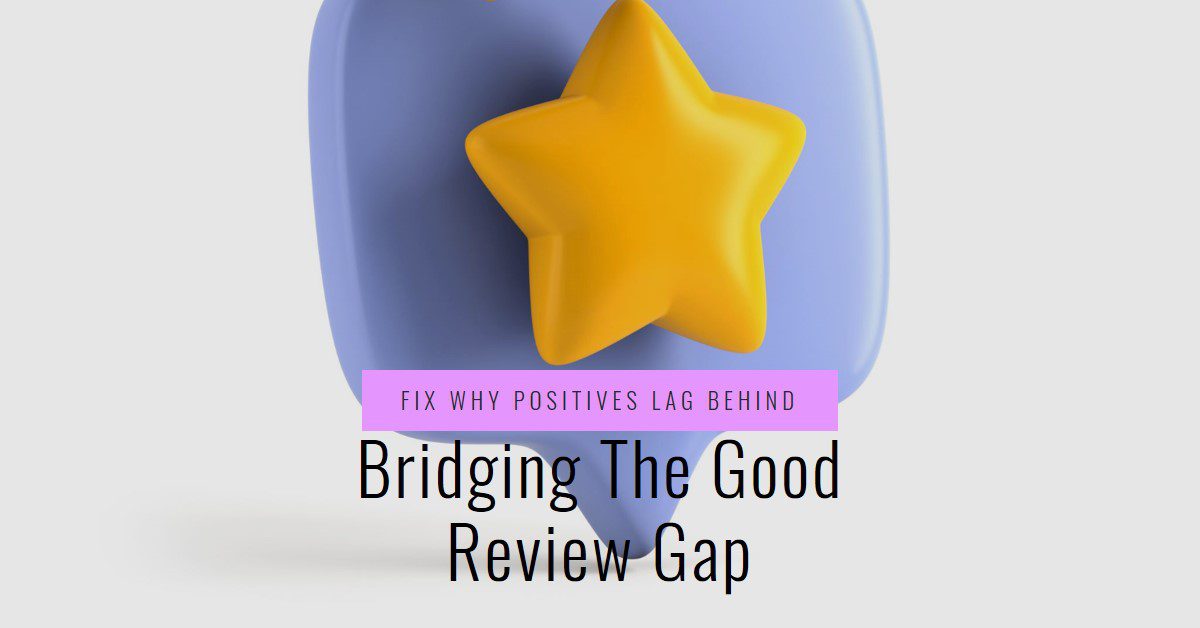
The Good Review Gap: Why Negatives Flow Fast & Positives Lag
Ever poured your heart into delivering a fantastic product or service? You know your customer left happy – maybe they even said so! So, you politely ask for a review, hoping for that shiny 5-star validation… and hear crickets. Yet, when something goes wrong? Boom. A detailed, sometimes scathing, negative review appears almost instantly. Frustrating, right? You’re not alone. This imbalance is a common headache for businesses.
Why the Radio Silence After a Great Experience?
-
The “Met Expectations” Paradox: Happy customers often see a smooth, positive experience as simply what was supposed to happen. It meets their baseline expectation. Because it wasn’t extraordinary in their minds (even if it was objectively great service), they don’t feel a strong urge to shout it from the rooftops. It was “just good,” and “good” doesn’t always trigger a review.
-
Inertia & Low Motivation: Leaving a review takes effort. Even a few minutes feels like a chore. Satisfied customers, while content, often lack the intense motivation that frustration provides. They move on with their busy lives.
-
Unclear “Why”: If you just say “Leave us a review!” without explaining why it matters to them or to you, it feels like an impersonal request. They don’t see the value for themselves in taking the time.
-
Friction in the Process: If finding your review page requires a treasure map, or the review platform is clunky, even a mildly happy customer won’t bother. Friction kills action.
-
Forgetting: Simply put, they forget. Life gets in the way. By the time they see your request, the positive feeling might have faded, replaced by the next task on their list.
And Why the Lightning-Fast Negative Reviews?
-
Emotional Fuel: Frustration, anger, and disappointment are powerful motivators. A negative experience creates a strong emotional impulse to vent, seek redress, or warn others. This energy translates directly into action – writing that review now.
-
Seeking Resolution (Sometimes): Some customers leave negative reviews hoping it will force the business to pay attention and fix their problem, especially if they feel other channels didn’t work.
-
Sense of Duty: They genuinely believe they are helping others avoid a bad experience. This perceived altruism drives immediate action.
-
Lower Barrier to Rant: Venting frustration often feels easier and more cathartic than crafting a thoughtful positive review. The words flow faster when fueled by emotion.
My Take: Turning the Tide & Encouraging Those Positive Reviews
We can’t eliminate negative reviews (nor should we want to – they offer valuable feedback!), but we can significantly increase the chances of happy customers speaking up. Here’s what I believe works:
-
Timing is EVERYTHING:
-
Ask at the Peak of Satisfaction: Don’t wait weeks. Ask right after the positive interaction – when they’ve received the product and love it, right after a successful service call, immediately after a positive support interaction. Strike while the emotional iron is hot!
-
Automate (Wisely): Use post-purchase emails, SMS, or app notifications triggered by key positive moments (e.g., delivery confirmation + 2 days for product testing).
-
-
Make it Effortless (Seriously, Remove Every Barrier):
-
Direct Links are Non-Negotiable: Never just say “Review us on Google!”. Provide a single, direct clickable link that takes them straight to your review page on the exact platform you want. Test this link yourself!
-
Simplify the Ask: Keep the request concise. “Loved your experience? It would mean the world if you could share it in a quick 2-minute review here.
-
Mobile-Optimized: Ensure the review process is seamless on a phone. Most people will do it there.
-
-
Explain the “Why” (Make it Personal & Impactful):
-
Benefit to Them (Subtly): “Your feedback helps us keep improving for you!” or “See what other customers like you think? Your review helps them decide!” (Social proof loop).
-
Benefit to You (Humanize): “As a small business, your reviews make a huge difference in helping us grow and reach more customers like you.” People like supporting businesses they like.
-
-
Personalize the Request:
-
Use their name.
-
Reference their specific purchase or interaction if possible (e.g., “Hope you’re loving your new Product or Service!”.
-
A personalized email from a real person (e.g., the account manager or owner) often performs better than a generic automated one.
-
-
Guide Them (Especially for Detailed Reviews):
-
“What did you love most about Product/Service?”
-
“How did Specific Feature help you?”
-
“Would you recommend us to a friend? Why?” This prompts positive, specific feedback.
-
-
Consider Gentle Incentives (Use Ethically & Check Platform Rules!):
-
A small discount on a future purchase after a review is submitted (positive or negative – this is crucial to avoid bias) can work. Never offer incentives only for positive reviews – it’s unethical and often against platform terms. Transparency is key: “Leave us an honest review and get 10% off your next order!”
-
-
Make Reviews Part of Your Culture (For Service Businesses):
-
Train staff to mention at the end of a positive interaction: “So glad we could help! If you have a quick moment, we’d really appreciate you sharing your experience on [Platform] – here’s a direct link if it’s easier.” Hand them a card with the link QR code.
-
The Bottom Line:
Happy customers aren’t unhappy; they’re just often unmotivated and busy. Negative experiences create instant, powerful motivation. Your job is to capture that positive sentiment at its peak, make the act of reviewing ridiculously easy, and clearly communicate the value of their voice. Reduce the friction, amplify the “why,” and personalize the ask. You won’t get a review from everyone, but you’ll significantly increase the chances of your satisfied “Silent Majority” becoming your most powerful advocates.
What quick tip will you try first? Share your review-request wins (or frustrations!) in the comments below!
